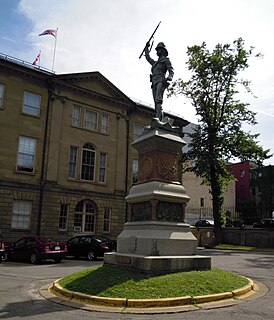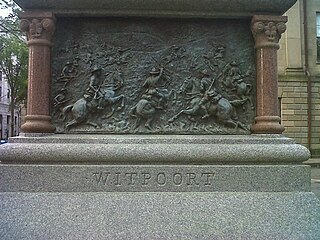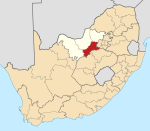The Devonian is a geologic period and system of the Paleozoic, spanning 60 million years from the end of the Silurian, 419.2 million years ago (Mya), to the beginning of the Carboniferous, 358.9 Mya. It is named after Devon, England, where rocks from this period were first studied.

Scorpions are predatory arachnids of the order Scorpiones. They have eight legs and are easily recognized by the pair of grasping pedipalps and the narrow, segmented tail, often carried in a characteristic forward curve over the back, ending with a venomous stinger. Scorpions range in size from 9 mm / 0.3 in. to 23 cm / 9 in..

Province House in Halifax is where the Nova Scotia legislative assembly, known officially as the Nova Scotia House of Assembly, has met every year since 1819, making it the longest serving legislative building in Canada. The building is Canada's oldest house of government. Standing three storeys tall, the structure is considered one of the finest examples of Palladian architecture in North America.

Canning is a village in northeastern Kings County, Nova Scotia located at the crossroads of Route 221 and Route 358.

Witpoort is a suburb of Johannesburg, South Africa. It is located in Region 2. Site of the Battle of Witpoort during the Second Boer War.
Dutoitia is a genus of Devonian rhyniophyte, named after the renowned South African geologist Alex du Toit. It is one of the earliest plants from Gondwana to colonize land. Its fossils were preserved in fine mudstones of the 400-million-year-old Bokkeveld and Witteberg Groups of South Africa. This erect, gracile plant is less than 10 cm high and very simple in structure. Its diminutive stems, which are devoid of leaflike appendages, branch in two and end in club- or cup-shaped sporangia, occasionally containing its reproductive spores. Stomata are present in the cuticle of their stems for gas exchange, and primitive cells inside the stems transported water from the roots to the aerial parts of the plant. Three species are recognized, D. pulchra Hoeg 1930, D. alfreda Plumstead 1967 and D. maraisia Plumstead 1967.

Lieutenant Harold Lothrop Borden was from Canning, Nova Scotia and the only son of Canada's Minister of Defence and Militia, Frederick William Borden and related to future Prime Minister Robert Laird Borden. Serving in the Royal Canadian Dragoons, he became the most famous Canadian casualty of the Second Boer War. Queen Victoria asked F. W. Borden for a photograph of his son, Prime Minister Wilfrid Laurier praised his services, tributes arrived from across Canada, and in his home town a monument was erected to his memory.

Hamilton Thomas Carlton Plantagenet MacCarthy was one of the earliest masters of monumental bronze sculpture in Canada. He is known for his historical sculptures, in particular his Pierre Dugua, Sieur de Mons at Annapolis Royal, Nova Scotia (1904) as well as Samuel de Champlain overlooking Parliament Hill on Nepean Point, Ottawa (1915), next to the National Gallery of Canada. His monument to the Ottawa volunteers who died in the South African War (1902) was moved to Confederation Park in 1969 after several moves. Other works include that of Ottawa mayor, Samuel Bingham, in Notre-Dame Cemetery in Vanier.

The South African War Memorial is a memorial located in the courtyard of Province House in Halifax, Nova Scotia, Canada

The Battle of Witpoort was a battle during the Second Anglo-Boer War. Major Frederick Henry Munn commanded the detachment of the Royal Irish Fusiliers at Witpoort which was attacked on 16 July 1900, his orders being to "hold his position at all costs". The Boers called on Major Munn to surrender, but, scornfully refusing, he held out from daybreak till 2 pm, when the Canadian forces mounted a counterattack and the Boers retired. The battle became famous because of the death of Harold Lothrop Borden.
This list of fossil arthropods described in 2013 is a list of new taxa of trilobites, fossil insects, crustaceans, arachnids and other fossil arthropods of every kind that have been described during the year 2013. The list only includes taxa at the level of genus or species.

Gondwanascorpio emzantsiensis is an extinct Gondwanan scorpion that lived 360 million years ago in the Devonian. Its fossil remains, clearly showing pincer and sting, were discovered in rocks of the Witteberg Group near Grahamstown in South Africa. At present this scorpion is the oldest known land-dwelling animal from Gondwana, which in Devonian times was separated from Laurasia by a deep ocean. At the time, the fossil site was only 15° from the South Pole, but rather than arctic like tundra, the region was probably wooded, providing ample insect life for food. Previously only two scorpion species were known from the late Devonian – Hubeiscorpio gracilitarsus from China and Petaloscorpio bureaui from Canada. The species was described by Robert Gess of Wits University in the journal African Invertebrates. The specific epithet derives from umZantsi, the isiXhosa word for "south", sometimes used for South Africa.

Priscomyzon riniensis is an extinct lamprey that lived some 360 million years ago during the Famennian in a marine or estuarine environment in South Africa. This small agnathan is anatomically similar to the Mazon Creek lampreys, but is some 35 million years older. Its key developments included the first known large oral disc, circumoral teeth and a branchial basket.
This list of fossil fishes described in 2015 is a list of new taxa of jawless vertebrates, placoderms, acanthodians, fossil cartilaginous fishes, bony fishes and other fishes of every kind that have been described during the year 2015, as well as other significant discoveries and events related to paleontology of fishes that occurred in the year 2015. The list only includes taxa at the level of genus or species.

Antarctilamna is an extinct genus of shark, that lived during the Devonian period.
Africanaspis is an extinct genus of groenlandaspidid placoderm known from two species, Africanaspis doryssa, named in 1997 from fossils discovered in South Africa and Africanaspis edmountaini, named from fossils described from South Africa during 2017. A. edmountaini is only known from juvenile specimens. Both species are known from the Witpoort Formation.
















